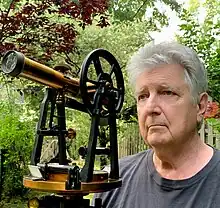
William Francis Romain (born 1948) is an American archaeologist, archaeoastronomer, and author. William Romain received his Ph.D. in archaeology from the University of Leicester and M.A. and B.A. degrees in anthropology from Kent State University. He specializes in the study of ancient religions, cognitive archaeology, and archaeoastronomy. William Romain is a Research Associate with the Indiana University, Department of Earth and Atmospheric Sciences and Assistant Editor for the Journal of Astronomy in Culture. He serves on the editorial board of the Midcontinental Journal of Archaeology and is a Fellow of the Royal Geographical Society and The Explorers Club. Romain has served as an advisor to the Board of Trustees for the Heartland Earthworks Conservancy,[1] as well as Research Associate with the Indiana University, Museum of Archaeology and Anthropology and Newark Earthworks Center at Ohio State University. He is a recipient of the Archaeological Society of Ohio's Robert Converse award for Outstanding Contributions to Ohio Archaeology.[2] William Romain is a licensed private pilot (fixed wing aircraft) and holds certification in marine celestial navigation. He has conducted archaeoastronomic fieldwork in the Eastern United States, China, Inner Mongolia, Tibet, Thailand, Cambodia, and Myanmar (Burma).
In 2011 Romain led a team of archaeologists (The Serpent Mound Project) in an investigation of Serpent Mound, in Adams County, Ohio.[3] This was the first major investigation of the effigy in more than one hundred years and included Geoprobe coring, hand coring, limited excavation, ground-penetrating radar, and electric resistivity analysis. Among the results were new radiocarbon dates for the effigy suggesting it was built about 2,300 years ago by people of the Early Woodland period.[4][5] Other work has included archaeoastronomic assessments for Poverty Point and Watson Brake in Louisiana, Mound City in Ohio, the Newark Earthworks, Great Hopewell Road in Ohio, and Cahokia in Illinois.[6][7] Most recently William Romain has published new archaeoastronomic findings for Angkor Wat in Cambodia,[8] the Great Ziggurat of Ur in Iraq,[9] Xanadu in Inner Mongolia,[10] and the Jokhang, Samye, and Tradruk temples in Tibet.[11]
Romain's research identified multiple solstice alignments at Poverty Point and Watson Brake. Watson Brake is the earliest known geometrically-shaped earthwork in North America. At Cahokia in Illinois, Romain showed how Rattlesnake Causeway and Rattlesnake Mound were likely associated with the Milky Way Path of Souls and how orientation to the Milky Way likely accounts for the site's peculiar 5-degree skew from true north. Research at Angkor identified multiple solstice alignments for Angkor Wat and more than a dozen surrounding temples. Also proposed were geomantic and archaeoastronomic explanations for the location of Angkor Wat and Rong Chen temple. At Ur, in Mesopotamia, Romain found that not only is the Great Ziggurat lunar-aligned - but the entire city is lunar aligned. (The moon was the patron god for Ur.) Research at Xanadu in Inner Mongolia showed how the summer palace for Kublai Khan was situated and oriented with respect to feng shui concepts and the winter and summer solstices. Research in Tibet provided explanations for the locations and orientations the Jokhang, Samye and Tradruk temples and showed how the emperors' tombs in the Chongye Valley were oriented to selected mountains having legendary importance. Most recently Romain [12] has documented the probable location and celestial alignments for the St. Louis Mound Group in St. Louis, Missouri. This group of 25 mounds located across the Mississippi River from Cahokia was leveled in the 1800s as a result of urban development.
Books
- An Archaeology of the Sacred: Adena-Hopewell Astronomy and Landscape Archaeology (The Ancient Earthworks Project, 2015)
- Shamans of the Lost World: A Cognitive Approach to the Prehistoric Religion of the Ohio Hopewell (AltaMira Press, 2009)
- Mysteries of the Hopewell: Astronomers, Geometers, and Magicians of the Eastern Woodlands (University of Akron Press, 2000)
References
- ↑ "Heartland Earthworks Conservancy is Founded « Heartland Earthworks Conservancy". www.earthworksconservancy.org. Retrieved 2 March 2019.
- ↑ "Ohio Archaeologist: Volume 42, Number 2 (Spring, 1992)". 2 March 1992. hdl:1811/55904.
{{cite journal}}: Cite journal requires|journal=(help) - ↑ Jessica E. Saraceni (March 30, 2011). "Archaeology Magazine News Archive 2008-2012". Archaeology Magazine. Retrieved 2 March 2019.
- ↑ Herrmann, Edward W.; Monaghan, G. William; Romain, William F.; Schilling, Timothy M.; Burks, Jarrod; Leone, Karen L.; Purtill, Matthew P.; Tonetti, Alan C. (2014). "A new multistage construction chronology for the Great Serpent Mound, USA". Journal of Archaeological Science. 50: 117–125. Bibcode:2014JArSc..50..117H. doi:10.1016/j.jas.2014.07.004.
- ↑ Romain, William (2019). "Serpent Mound in its Woodland Period Context: Second Rejoinder to Lepper". Midcontinental Journal of Archaeology. 44 (1): 57–83. doi:10.1080/01461109.2018.1511155. S2CID 165272228.
- ↑ Romain, William F. (2018) "Ancient Skywatchers of the Eastern Woodlands". In Archaeology & Ancient Religion in the American Midcontinent, edited by Brad H. Koldehoff and Timothy R. Pauketat. University of Alabama Press, Tuscaloosa.
- ↑ Romain, William F. (2015) "Adena-Hopewell Earthworks and the Milky Way Path of Souls". In Tracing the Relational: The Archaeology of Worlds, Spirits, and Temporalities, edited by Meghan E. Buchanan and B. Jacob Skousen, pp. 54-82. University of Utah Press, Salt Lake City.
- ↑ Romain, William F. (2018). "Solstice Alignments at Angkor Wat and Nearby Temples: Connecting to the Cycles of Time". Journal of Skyscape Archaeology. 4 (2): 176–200. doi:10.1558/jsa.35712. ISSN 2055-3498. S2CID 86799374.
- ↑ Romain, William F. (2019). "Lunar alignments at Ur: Entanglements with the Moon God Nanna". Journal of Skyscape Archaeology. 5 (2): 151–176. doi:10.1558/jsa.39074. ISSN 2055-3498. S2CID 215828817.
- ↑ Romain, William F. (2017-04-03). "The archaeoastronomy and feng shui of Xanadu: Kublai Khan's imperial Mongolian capital". Time and Mind. 10 (2): 145–174. doi:10.1080/1751696X.2017.1310567. ISSN 1751-696X. S2CID 164633207.
- ↑ Romain, William (2021). "Subduing the Demons of Tibet: Geomantic Magic During the Yarlung Dynasty: A Landscape Archaeology Assessment". Time and Mind: The Journal of Archaeology, Consciousness and Culture. March 2021: 33–71. doi:10.1080/1751696X.2021.1864946. S2CID 233016068.
- ↑ Romain, William. "In Search of the St. Louis Mound Group: Archaeoastronomic and Landscape Archaeology Implications". Journal of Astronomy in Culture. 2 (1).